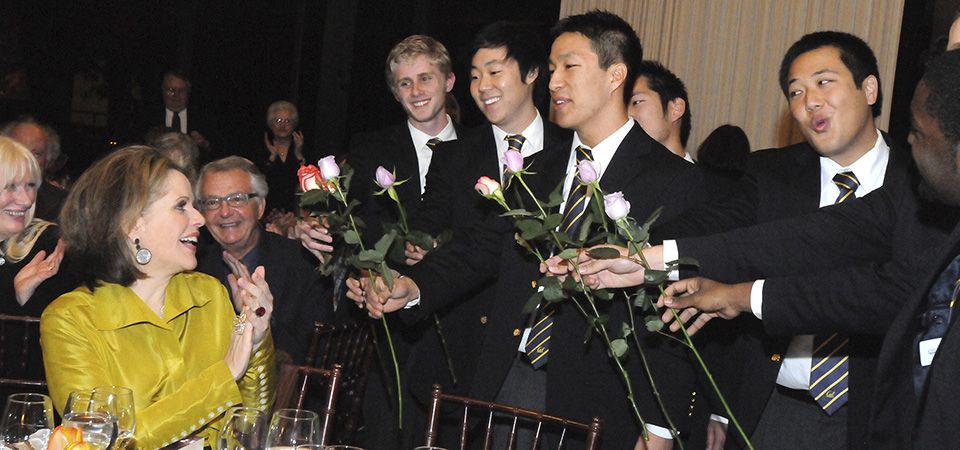About
UC Choral Ensembles, also known as UCCE, offers students many exciting learning and performance opportunities including the development of musical and vocal skills and the exploration of a wide-variety of musical styles. Performances range from formal concerts with professional soloists and orchestra to participation in Cal Spirit events. UCCE is comprised of eight groups:
UC Choral Ensembles is the center for extra-curricular choral activities at UC Berkeley. It is an active, fun, and popular student organization. Several groups have produced their own CD recordings and many of our ensembles tour. These tours have included trips to Southern California, Oregon, New Orleans, New York City as well as Japan, China, Hungary, England, Czech Republic, Spain and Italy. The nine ensembles of UCCE offer students a rich variety of exciting learning and performing opportunities, including the chance to:
- Develop musical and vocal skills. Within a two-year span, a first-time singer, trained in the UC Men’s Chorale, found himself on the Carnegie Hall stage helping the UC Men’s Octet win the International Championship of Collegiate A Cappella (ICCA).
- Explore a wide variety of musical styles. UCCE has groups specializing in almost all musical genres including, but not limited to pop, jazz, barbershop, classical, and musical theater.
- Participate both musically and socially with students from every academic discipline. Upon receiving his bachelors degree in Business and his first series of vocal coachings from one of UCCE’s staff instructors, a recent graduate is the only auditionee in the area named to the national touring company of Rent.
Performances range from formal concerts with professional soloists and orchestra to participation in Cal “spirit” events. All UCCE groups take part in the annual Fall Retreat, Halloween Show, the famous Cal vs. Stanford Sing-Off, Holiday Concert, Caroling in San Francisco, and the AIDS benefit concert. Whether you are an experienced musician, a first-time singer, or a budding thespian, there is a place for you in UC Choral Ensembles.
UC Choral Ensembles is a member of Student Musical Activities, a subsidiary of Cal Performances. SMA is a thriving center for extra-curricular music training and performance at Berkeley. Complementing and augmenting Music Department performance opportunities, SMA is run by and for students interested instruction in choral, jazz, and marching band repertoire. SMA supports students in the development of musical skills as well as experience in group and arts management.
History of UC Choral Ensembles
UC Choral Ensembles offers a diverse and dynamic extracurricular vocal program for students and alumni of UC Berkeley. This organization is part of a tradition that dates as far back as the establishment of an octet of male singers in 1875 which evolved soon thereafter into the “Men’s Glee Club.” The first record of a women’s singing group was the ladies’ “Mandolin Society” founded in the late 1880s. The (Ladies’) Mandolin Society’s name changed to “Treble Clef” sometime before 1900. Clinton R. “Brick” Morse directed the Men’s Glee Club from 1896 until 1921. Today, his name is known primarily to singers because of the compositions, “Hail to California” and “Sons of California,” two of many that have withstood the test of time.
During the twenties and early thirties, the UC Glee Club established strong ties with various organizations, in particular the Fox Theater in San Francisco and Los Angeles and the National Broadcasting System. Both organizations regularly called upon the Glee Club for performances.
The UC Glee Club reached 125 singers in the mid-30s, the largest groups ever recorded in its 125-year history. This era saw the groups singing jointly from the top of the Campanile, the Glee Club performing well over 100 engagements a year, travels all over California, particularly Southern California for alumni banquets and other events.
In 1942 the singing groups became the ‘army behind the army’—serving as helpmates of the USO. The ensuing war years saw the Glee Club shrink to a low of 15 and the Treble Clef to as high as 110 members. The women pulled out all the stops with three different concerts in Wheeler Auditorium and visited camps and hospitals on a regular basis. They performed at the memorial in San Francisco for Franklin D. Roosevelt. The traditional December Christmas Caroling across campus was another important contribution made by the Treble Clef during these years.
The Treble Clef and Glee Club put on a variety of shows often including original music written by students. They collaborated with “Masque and Dagger,” the extracurricular drama club, for direction, makeup and the like. When instruments were needed, members of the Cal Band helped out. Glee Club, in turn, sometimes assisted the Cal Band in half-time stunts or at rallies. At football games Glee Club sat in the first few rows of the men’s rooting section and when the Band played Cal songs the microphones were turned around to catch the singers. At half time, Treble Clef filled the Band seats in the rooting section for card stunts. Small singing groups came and went—there were small singing groups outside Glee Club and Treble Clef, as well. In 1948, an objective was to have several smaller groups that could fill engagements too small for the full club. An octet was formed called the “Senior Octet.” The first group was made up of seniors, but the second semester they dipped down into lower classes for members.
The “Golden Age of Choral Singing” (generally regarded in America as the 50s and early 60s) was ushered into Cal extracurricular singing with the leadership of Bob Commanday. He established a new choral group, the Collegians, a non-audition group that focused on developing sight reading skills—but also performed along with the traditional groups. The look and the sound of the groups improved dramatically. The men wore either Cal-blue blazers or tuxedos. Social mixers were plentiful, bringing together the Glee Club, Treble Clef, Collegians and eventually several other groups. Annual tours for the Glee Club re-emerged with the Treble Clef doing weekend outings. By 1955 the Collegians grew to 90 members. A JV Men’s Glee Club, a sub-group of the Men’s Glee Club, was organized in 1956 and grew from 18 to 40 members in one semester.
The early sixties reflected the culmination of the long, steady hand and talent of SMA-V director Bob Commanday. Performances with Ella Fitzgerald in San Francisco and television appearances on Easter Sunday were sprinkled amongst traditional activities such as Nob Hill regent luncheons and the like. The Glee Club and Treble Clef had about 100 singers each. The Men’s Octet was still a part of the Glee Club. In 1962, a small group of Treble Clef singers formed an ensemble called Jade—an antecedent of the Overtones/Decibelles. In the later fifties the Collegians, JV Men’s Glee Club as well as new small groups such as the Sea Shanteers and Madrigal Singers were commanding much time and attention of their own.
The years immediately after Bob Commanday resigned witnessed a bit of a downturn for extracurricular singing on the Cal campus. There were several different directors within four years. There was a general let-down in the intensity of the program and the passage of Proposition 13. During Milton Williams’ tenure as director, the inflow of singers slowed to a trickle and the Men’s Glee Club was forced to fold. The men and women combined their forces to form the Concert Chorale in 1971. The Men’s Octet became an independent group in the 60s. A group calling themselves the UC Chamber Singers began in 1970 but disbanded in 1976. Jade, the small women’s vocal ensemble, changed their name to Decibelles in 1972.
Carol Young assumed the director’s position in 1976 and remained for thirteen years. During this time, there was a resurrection of many groups, and the formation of new groups. The Cal Jazz Choir began in 1976 under the direction of Mike West. Perfect Fifth emerged in 1978 and continued until the mid-1990s. Perfect Fifth became the UC Madrigal Singers in 1996 (later changing back to the name Perfect Fifth). The UC Alumni Chorus was organized in 1985 as the aftermath of a “SMA-V” reunion. The Gospel Choir also began in 1985 and became part of the Music Department in 1996 where it remains today. Bear Stage Musical Theater began in 1986 then ‘changed’ their name to BareStage in 1995. It was during Carol Young’s tenure as director that the source of funding moved from the ASUC to the University, administered by Cal Performances’s director Robert Cole. Then under the direction of Anthony Pasqua and assistant director Wm. Garcia Ganz, the combined Concert Chorale went back to its original two groups in Spring 1991, first called the Men’s and Women’s Glee Clubs, then the Men’s Glee Club and the Women’s Chorale, and finally to the UC Men’s and Women’s Chorales.
In the early 90s, student leaders changed the overall organization’s name: Student Musical Activities-Vocal, or SMA-V, to UC Choral Ensembles or UCCE. An administrative assistant, Parrie Frinch-Smith, was assigned to UC Choral Ensembles (SMA-V) from the late 80s until 1998, when all of the administrative positions were realigned.
In 2000, UCCE’s newest a cappella group, Noteworthy joined UC Choral Ensembles now consisting of UC Men’s and Women’s Chorales, UC Alumni Chorus, UC Men’s Octet, California Golden Overtones, Cal Jazz Choir, Perfect Fifth, and BareStage.
Wm. Garcia Ganz remains associate director of UC Choral Ensembles to this day with the current director, Mark Sumner, named to the position in the Fall of 1997. Ganz conducts the Jazz Choir and Men’s Chorale. Sumner conducts the Women’s Chorale, Perfect Fifth, UC Alumni Chorus and the combined Chorales as well as supervises all of the groups from an administrative position.
Submitted by Mark Sumner, 2001.

